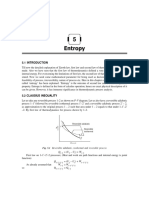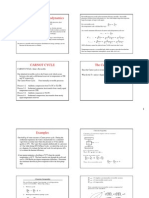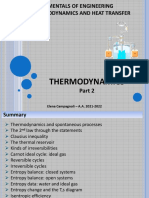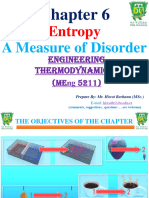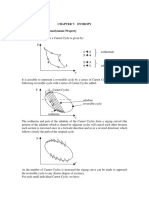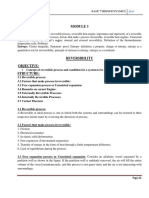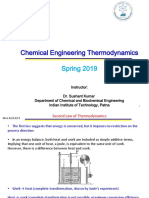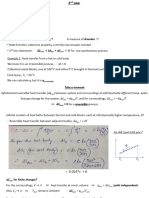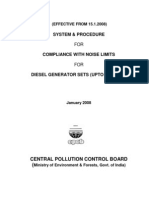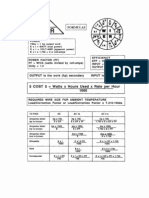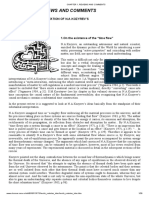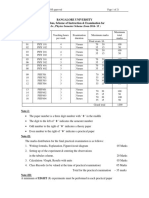Entropy
Dr. Rohit Singh Lather
�Introduction
It has already been proved that for a reversible cycle working between source and sink
temperatures, the heat supplied and rejected to the engine is related with source and sink
temperature as
1 2
=
1
2
That is, the ratio of energy absorbed to the energy rejected as heat by a reversible engine is equal
to the ratio of the temperatures of the source and the sink.
'(
'+
+ ) = 0
)(
+
�Replacement of a Reversible process by an equivalent process
Pressure
Let us consider cyclic changes in a system other than heat engines. If the cycle can be split up into a large
number of heat engine cycles then the above observation can be made use of in relating the heat interactions
with the absolute temperatures.
Any reversible process can be approximated by a series of reversible, isothermal and reversible, adiabatic
processes.
The same change of a state can be achieved by process
Reversible Process 1-2
1-a
Reversible adiabatic
process
c-2
Reversible adiabatic
process
U2-U1=Q1-a-b-c-2-W1-a-b-c-2
a-b-c
Isothermal process
The areas 1-a-b and b-c-2 are equal
Volume
Consider a reversible process 1-2
The same change of a state can be achieved by
- Process 1-a (reversible adiabatic process)
- Isothermal process a-b-c and a reversible adiabatic process c-2
The areas 1-a-b and b-c-2 are equal.
From the first law U2 - U1 = Q1-a-b-c-2 - W1-a-b-c-2
Consider the cycle 1-a-b-c-2-b-1. The net work of the cycle is zero
= W1-a-b-c-2 + W2-b-1 = 0
W1-a-b-c-2 = - W2-b-1 = W1-b-2
The heat interaction along the path 1-a-b-c-2 is
Q1-a-b-c-2 = Q1-a + Qa-b-c + Qc-2 = Qa-b-c Since 1-a and c-2 are reversible adiabatic paths
�.Hence,
U2 - U1 = Qa-b-c - W1-b-2
Application of the first law of the thermodynamics to the process 1-b-2 gives
U2 - U1 = Q1-b-2 - W1-b-2
Comparing the two equations
Qa-b-c = Q1-b-2
heat transferred in the process 1 2 is equal to heat
transferred in the isothermal process a b
The heat interaction along the reversible path 1-b-2 is equal to that along the isothermal path ab-c
Therefore a reversible process can be replaced by a series of reversible adiabatic and reversible
isothermal processes.
So any reversible path can be replaced by a zig-zag path between the same end states
The zig-zag path consists of a reversible adiabatic followed by a reversible isotherm and then by
a reversible adiabatic in such a way that will satisfy above equation i.e., the heat transferred
during the isothermal process is the same as that transferred during the original process
�Introduction to Clausius Theorem and Clausius Inequality
When a reversible engine uses more than two reservoirs, the third or higher numbered reservoirs
will not be equal in temperature to the original two
Consideration of expression for efficiency of the engine indicates that for maximum efficiency,
all the heat transfer should take place at maximum or minimum reservoir temperatures
- Any intermediate reservoir used will, therefore, lower the efficiency of the heat engine
Practical engine cycles often involve continuous changes of temperature during heat transfer
A relationship among processes in which these sort of changes occur is necessary
The ideal approach to a cycle in which temperature continually changes is to consider the system
to be in communication with a large number of reservoirs in procession
Each reservoir is considered to have a temperature differing by a small amount from the
previous one
�Clausius Theorem
A given cycle may be subdivided by drawing a family of reversible, adiabatic lines
Every two adjacent adiabatic lines may be joined by two reversible isotherms
isothermal path
Adiabatic Lines
Pressure
The heat interaction along the reversible path is equal to the heat interaction along the reversible
Reversible Cycle
Qa-b = Qa1-b1 and
Qc-d = Qc1-d1
a1-b1-d1-c1
is a Carnot cycle
The original reversible cycle thus is a split into a family of
Carnot cycles
Isothermal Lines
Volume
� The work interaction along the reversible path is equal to the work interaction along the
reversible adiabatic and the reversible isothermal path
For a1-b1-d1-c1 Carnot cycle
- aQ1 is added at contact temperature T1 and aQ2 is rejected at temperature T2
So we can write
1
2 '(
'+
=
+
= 0
1
2 )(
)+
'/
'0
+
= 0
)/
)0
'(
'+
+ ) + .......= 0
)(
+
'
2
)
=0
3'
)
=0
Clausius Theorem
�Clausius Inequality
Let us Consider cycle A-B-C-D
- AB is a general process, either reversible or irreversible
= 1 -
Temperature
- Let the cycle be divided into number of elementary cycles as shown
The efficiency of a general cycle is always less
than the efficiency of a reversible cycle
rev
1 -
(1 - )rev
Source: P K Nag, Engineering Thermodynamics", Mc Graw Hill Eductaion,5th Edition, 2016
Volume
- ( )rev
( )rev
I
I For cyclic process
( )rev
dS = 0 for a cyclic process
We know that (
)
=
rev
Replacing for
reversible
For any process A-B
For any process AB
For reversible process A-B
Clausius Inequality
�Thermal reservoir at Tres which delivers a small amount
of heat Q to a reversible cyclic engine
Reservoir at Temperature Tres
Reversible
Heat
Engine
engine delivers a
small amount of work
Heat rejected Q
Reservoir at Variable Temperature T
reservoir itself delivers a different
small amount of work W to the
surroundings
Source: Joseph M. Powers, Lecture notes on thermodynamics", University of Notre Dame, Notre Dame, Indiana, USA
�Q'O
Q'
Q'O
)RST
)RST
)
Q'
)
The first law in differential form for the combined system is
dE = () ( + )
Q is internal and so does not cross the boundary of the combined system and is not present in our first law formulation
Rearrange ( + ) = () dE
Replace Q ( + ) = (Tres
Q'
)
)
dE
Let this configuration undergo a thermodynamic cycle ( + = Tres
W + = Tres
Q'
)
Q'
dE
)
Apply the Kelvin-Planck form of the second law of thermodynamicsW + O 0
We cannot convert all the heat to work, but we can convert all the work to heat
Tres
Q'
0
)
Source: Joseph M. Powers, Lecture notes on thermodynamics", University of Notre Dame, Notre Dame, Indiana, USA
�And since Tres > 0, we can divide above equation by it, without changing the sense of the inequality
to get a mathematical representation of the second law of thermodynamics
Q'
) 0
=0
I
0
I
=0
This is known as Clausius Inequality
This is known as Clausius Inequality for a reversible process
This is known as Clausius Inequality for a irreversible process
For every Carnot cycle
Source: Yunus A. Cengel and Michael A. Boles Thermodynamics: An Engineering Approach, McGraw Hill, 8th Edition
The integral symbol with a circle in the middle is used to indicate that the integration is to be
performed over the entire cycle
Any heat transfer to or from a system can be considered to consist of differential amounts of
heat transfer
Then the cyclic integral of dQ/T can be viewed as the sum of all these differential amounts of
heat transfer divided by the temperature at the boundary
Whenever a system undergoes a cyclic change, however complex the cycle may be (as long as it
involves heat and work interactions), the algebraic sum of all the heat interactions divided by the
absolute temperature at which heat interactions are taking place considered over the entire cycle is
less than or equal to zero (for a reversible cycle)
Source: P K Nag, Engineering Thermodynamics", Mc Graw Hill Eductaion,5th Edition, 2016
� Consider starting from 1, proceeding on path A to 2,
and returning to 1 via path B.
The cyclic integral Q/T =0 decomposes to
+ Q'
(( )A
)
( Q'
(+ )B =
)
Pressure
Entropy Path-Independent Thermodynamic Property
A, B, & C are arbitrary processes
between state 1 and state 2
2
B
0
C
Perform the same exercise going from 1 to 2 on path
A and returning on path C, yielding
+ Q'
(( )A
)
( Q'
(+ )C =
)
1
Volume
Sketch of P V diagram for various
combinations of processes forming cyclic
integrals
Source: Joseph M. Powers, Lecture notes on thermodynamics", University of Notre Dame, Notre Dame, Indiana, USA
�( Q'
( Q'
(+ ) )B - (+ ) )C =
( Q'
( Q'
)
=
(
+ ) )C
) B
(+
+ Q'
+ Q'
(( ) )B = (( ) )C
We can reverse direction and recover the same result
Since paths B and C are different and arbitrary, but Q/T is the same on either path, the
integral must be path-independent.
It therefore defines a thermodynamic property of the system.
We define that property as entropy, S, an extensive thermodynamic property
+ Q'
S2 S1 =
( )
Source: Joseph M. Powers, Lecture notes on thermodynamics", University of Notre Dame, Notre Dame, Indiana, USA
�+ Q'
s2 s1=
( )
scale by the constant mass m to get the
corresponding intensive variable s = S/m
Differential Form
= .
+
] = ] .
(
1q2 =
+
( .
Integrating
This is the heat transfer equivalent to
Source: Joseph M. Powers, Lecture notes on thermodynamics", University of Notre Dame, Notre Dame, Indiana, USA
1w2=
+
( .
�The heat transfer for a process from 1 to 2 is given
by the area under the curve in the T s plane
If a process lies on a so-called Isentrope: a line on
which entropy s is constant, then, 1q2 = 0; thus, the
process is adiabatic
Above equation only applies for a reversible process
The entropy change between two specific
states is the same whether the process is
reversible or irreversible
Isentropic = Adiabatic + Reversible
Source: Joseph M. Powers, Lecture notes on thermodynamics", University of Notre Dame, Notre Dame, Indiana, USA
Yunus A. Cengel and Michael A. Boles Thermodynamics: An Engineering Approach, McGraw Hill, 8th Edition
�Example : For a particular power plant, the heat added and rejected both occur at constant
temperature and no other processes experience any heat transfer. The heat is added in the amount
of 3150 kJ at 440oC and is rejected in the amount of 1950 kJ at 20oC. Is the Clausius inequality
satisfied and is the cycle reversible or irreversible?
The Clausius inequality is satisfied
Since the inequality is less than zero, the cycle has at least one irreversible process and the cycle
is irreversible
Source: Yunus A. Cengel and Michael A. Boles Thermodynamics: An Engineering Approach, McGraw Hill, 8th Edition
�Example: For a particular power plant, the heat added and rejected both occur at constant
temperature; no other processes experience any heat transfer. The heat is added in the amount of
3150 kJ at 440oC and is rejected in the amount of 1294.46 kJ at 20oC. Is the Clausius inequality
satisfied and is the cycle reversible or irreversible?
The Clausius inequality is satisfied
Since the cyclic integral is equal to zero, the cycle is made of reversible processes
Source: Yunus A. Cengel and Michael A. Boles Thermodynamics: An Engineering Approach, McGraw Hill, 8th Edition
�Second Law in terms of Entropy Entropy Change in an Irreversible Process
I
0 Statement of second law valid for reversible and irreversible heat transfer
Definition of Entropy provided the heat transfers are reversible
Consider the cycle in the T S diagram as shown
- We start at 1, and proceed to 2 along path I, which
represents an irreversible process
- We return from 2 to 1 along path R, which represents a
Temperature
+ Q'
S2 S1 =
( )
reversible process
For a reversible process
+ Q'
S2 S1 =
( )
Source: Joseph M. Powers, Lecture notes on thermodynamics", University of Notre Dame, Notre Dame, Indiana, USA
1
Entropy
�Since the process is reversible, we reverse and get
( Q'
S1 S2 =
+ )
Now, apply the second law
+ Q'
0 ((
)
) I
( Q'
(+ ) )R
+ Q'
)
Now, substitute, to eliminate the integral along R to get 0 (
( ) I
+ Q'
S2 S1 (
)
( ) I
More generally, we can write the second law of thermodynamics as,
S1 S2
+ Q'
S2 S1
( )
If 2 1 is reversible, the equality holds; if 1 2 is irreversible, the inequality holds
For an isolated system, there can be no heat transfer interactions and = 0,
So S2 S1 0,
Isolated system
- This implies 2 occurs later in time than 1
- Thus, for isolated systems, the entropy increases as time moves forward
Example: Two large thermal reservoirs, one at TA and the other at TB, exchange a finite amount of
heat Q with no accompanying work exchange. The reservoirs are otherwise isolated and thus form
their own universe, when considered as a combined system. Consider the implications for entropy and
the second law.
A
TA
B
TB
Heat transfer from A to B
Source: Joseph M. Powers, Lecture notes on thermodynamics", University of Notre Dame, Notre Dame, Indiana, USA
� Assume for now that positive Q leaves A and enters B
Both A and B are so massive that the respective loss and gain of thermal energy does not alter
their respective temperatures. Consider the entropy changes for each system:
+ Q'
)
SA2 SA1 = (
SB2
'
= ) ( = )
+ Q'
SB1 = (
)
( +
= ) (
_
'
)_
Now, our universe is the combination of A and B, so the entropy change of the universe is found by
adding the entropy changes of the components of the universe
(SA2 + SB2) (SA1 +
= SU2
'
SB1) =
)_
'
)^
= SU1
With the universe entropy SU as SU = SA + SB , we get SU2 SU1
(
=Q(
)_
Source: Joseph M. Powers, Lecture notes on thermodynamics", University of Notre Dame, Notre Dame, Indiana, USA
(
)
)^
�The universe is isolated, so the second law holds that SU2 SU1 0; thus, Q (
(
)_
- ) ) 0
^
Now, we have assumed Q > 0; therefore, we can divide by Q without changing the sense of the
inequality:
(
(
0
)_ )^
)^ ` )_
)^)_
Since TA > 0 and TB > 0, we can multiply both sides by TATB without changing the sense of the
inequality to get
0
We have thus confirmed that our mathematical formulation of the second law in terms of entropy
yields a result consistent with the Clausius statement of the second law.
We must have TA TB in order to transfer positive heat Q from A to B
�Entropy Change of an Isolated System
6-3
The principle of entropy increase: The entropy of an isolated system can never decrease. It always
increases with every irreversible process and remains constant, only when the process is reversible.
The entropy of an isolated system either increases or, in the limit, remains constant.
`Q'
dSsys = )
TcT
System
Tsys
Surroundings
Tsur
SQ
Q'
dSsur = )
TdR
dSiso = dSsys + dSsur
(
= [ )
TdR
- ) ] > 0
TcT
The entropy of an isolated system either increases if it undergoes an irreversible process
If, Tsys = Tsur, the process would occur reversibly and entropy will remain constant
The entropy change of an isolated system is the sum of the entropy changes of its components, and
is never less than zero
Source: D. S. Kumar, Engineering Thermodynamics", S.K. Kataria & Sons, 2nd Edition
�Entropy
Second law of thermodynamics while applied to a process give rise to a property, called entropy
Absolute entropy (S) or entropy is a measure of energy dispersion in a system
Following are basic features of entropy:
- Entropy transfer is associated with heat transfer
- Entropy is proportional to mass flow in an open system
- Entropy does not transfer with work
Heat to Work
Entropy Transfer
Work to Work
No Entropy Transfer
Work to Heat
No Entropy Transfer; Entropy Generates
If no irreversibilities occur within the system as well as the reversible cyclic device,
- Then the cycle undergone by the combined system will be internally reversible
- As such, it can be reversed
In the reversed cycle case, all the quantities will have the same magnitude but the opposite
sign
- Therefore, the work WC, which could not be a positive quantity in the regular case, cannot be a
negative quantity in the reversed case
- Then it follows that WC,int rev = 0 since it cannot be a positive or negative quantity, and therefore
for internally reversible cycles
Thus we conclude that the equality in the Clausius inequality holds for totally or just internally reversible
cycles and the inequality for the irreversible ones.
Source: Yunus A. Cengel and Michael A. Boles Thermodynamics: An Engineering Approach, McGraw Hill, 8th Edition
�Some Remarks about Entropy
Entropy change of the system will have the same sign as the heat transfer in a reversible
process
Processes can occur in a certain direction only, not in just any direction, such that Sgen 0
Entropy is a non-conserved property, and there is no such thing as the conservation of entropy
principle
The entropy of the universe is continuously increasing, as all the processes happening in the
universe are irreversible
The performance of engineering systems is degraded by the presence of irreversibilities
Entropy generation is a measure of the magnitudes of the irreversibilities present during that
process
Entropy change is caused by heat transfer and irreversibilities
Source: Yunus A. Cengel and Michael A. Boles Thermodynamics: An Engineering Approach, McGraw Hill, 8th Edition
� Heat transfer to a system increases the entropy; heat transfer from a system decreases it
The effect of irreversibilities is always to increase the entropy
- In fact, a process in which the heat transfer is out of the system may be so irreversible that
the actual entropy change is positive (Friction is one source of irreversibilities in a system)
The entropy change during a process is obtained by integrating the dS equation over the process
The inequality is to remind us that the entropy change of a system during an irreversible process
+
is always greater than ( /, called the entropy transfer
- That is, some entropy is generated or created during an irreversible process
- Generation is due entirely to the presence of irreversibilities.
The entropy generated during a process is called entropy generation and is denoted as Sgen
Source: Yunus A. Cengel and Michael A. Boles Thermodynamics: An Engineering Approach, McGraw Hill, 8th Edition
� We can remove the inequality by noting the following
+
= 2 1 = I
- Sgen is always a positive quantity or zero
- Its value depends upon the process and thus it is not a property
- Sgen is zero for an internally reversible process
+
The integral ( / is performed by applying the first law to the process to obtain the heat
transfer as a function of the temperature. The integration is not easy to perform, in general
Source: Yunus A. Cengel and Michael A. Boles Thermodynamics: An Engineering Approach, McGraw Hill, 8th Edition
�Temperature
Heat Transfer as the 6-9
Area under a T-S Curve
2
Internally Reversible Process
dA = TdS = Q
1
Entropy
For the reversible process, the equation for dS implies that or the incremental heat transfer in a process is the
product of the temperature and the differential of the entropy, the differential area under the process curve
plotted on the T-S diagram
�Heat Transfer for a Internally Reversible Process
dA = TdS = Q
Temperature
Internally Reversible Process
Temperature
Temperature
6-9
Isothermal Process
Adiabatic Process
1
Entropy
Entropy
Entropy
+
= T( = (S2 S1)
On a T-S diagram, the area under the process curve represents the heat transfer for internally reversible
processes
�Reversible Adiabatic Processes
Heat exchange with a single
reservoir in the process AB
For a reversible adiabatic process, heat interactions are zero so
Two adiabatic reversible paths never intersect each other
Entropy is a property and a point function
Through one point, there can only pass one reversible
Pressure
change in entropy is zero
adiabatic line
If, two adiabatic reversible paths intersect each other, then
entropy will have two values at that point, this violates Kalvin
Planks statement (engine which exchanges heat with a single
reservoir)
Volume
Violates Kelvin Plank Statement
�h-s Diagram for Adiabatic Steady Flow Devices
6-11
Enthalpy (h)
For adiabatic steady-flow devices, the vertical distance is h on an h-s diagram, and the horizontal
distance is s
measure of work
h
2
s
Entropy
measure of irreversibilities
� Temperature-entropy and enthalpy-entropy diagrams for water
The h-s diagram, called the Mollier diagram, is a useful aid in solving steam power plant problems.
The Mollier diagram shows only two
regions, the mixed region of vapor and
liquid and the super-heated vapor steam
region.
The two regions are separated by the
downward sloping saturation line, where
steam quality is equal to 1
Super-heated Vapor Steam Region
Constant Temperature
Lines
Mixed Region
of vapor and liquid
Steam Quality
Lines
�Constant Volume and Constant Pressure Lines on T-S Diagram
Constant volume
Constant pressure
ds= Cv
ds=
3)
)
3)
Cp
)
Slope of constant volume line on T-S diagram
3)
3o
3)
Slope of constant pressure line on T-S diagram
3o
)
pq
)
pr
As Cp > Cv, Constant volume lines on T-s diagram is steeper than constant pressure line, working
between the same temperature limits
3)
3o
For both Constant volume and constant pressure
�Level of Molecular Disorder (Entropy)
The level of molecular disorder (entropy) of a substance increases as it melts and evaporates
Net disorder decreases during heat transfer
During a heat transfer process, the net disorder (entropy) increases
the increase in the disorder of the cold body more than offsets the decrease in the disorder in the hot body
�Third Law of Thermodynamics
The third law of thermodynamics states that The entropy of a pure crystalline substance at
absolute zero temperature is zero.
This law provides an absolute reference point for the determination of entropy
The entropy determined relative to this point is called absolute entropy
